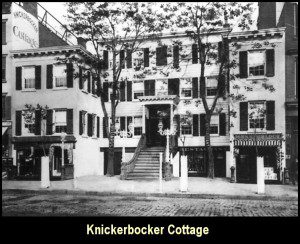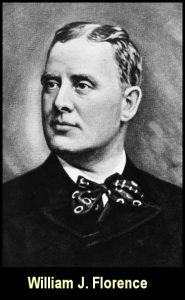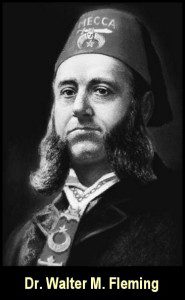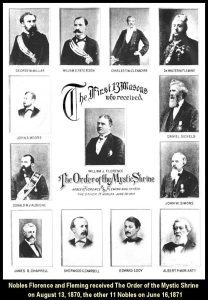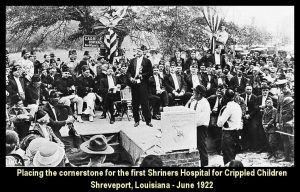Introduction
What is a Shriner? What kind of organization attracts truck drivers, dentists, contractors, heads of state, movie stars, generals, clergymen and accountants? What is the Shrine?
Someone might answer: “Oh yeah, Shriners are those guys who always have those parades with the wild costumes and funny little cars.” Another might think of Shrine circuses and Shrine clowns. The fellow next to him might interject, “No, Shriners are the guys who wear those funny hats — like flowerpots — and have those big conventions.”
“I don’t know about that,” a passerby might add. “But I do know my little girl was born with club feet and now they are straight, and she can walk like anyone else, thanks to Shriners Hospitals for Children.”
“She can walk?” questions still another. “I thought the Shriners ran those fantastic burn hospitals. I’ve read stories about them saving kids with burns on 90 percent of their bodies.”
All those people are right. Each has experienced an aspect of Shrinedom. What they cannot experience, unless they are Shriners, is the camaraderie, deep friendships, good fellowship and great times shared by all Shriners. What they may not know is that all Shriners share a Masonic heritage: Each is a Master Mason in the Freemasonry Fraternity.
Historically, Masons had to become members of the York or Scottish Rite Bodies before becoming a Noble of the Shrine. However, at the Imperial Council Session in July 2000, an amendment to Shrine law changed that requirement, allowing Master Masons to become Shriners directly.
There are nearly 500,000 Shriners now. They gather in Temples, or chapters, throughout the United States, Canada, Mexico and the Republic of Panama. There are 22 Shriners Hospitals for Children — 18 orthopaedic hospitals, three burn hospitals, and one hospital that provides orthopaedic, burn and spinal cord injury care. These hospitals have cured or substantially helped more than 700,000 children — at no cost to parent or child — since the first Shriners Hospital opened in 1922.
How did it all start? How does it work? What is the Shrine?
The Evolution of The “World’s Greatest Fraternity”
In 1870, several thousand of the 900,000 residents of Manhattan were Masons. Many of these Masons made it a point to lunch at the Knickerbocker Cottage, a restaurant at 426 Sixth Avenue. At a special table on the second floor, a particularly jovial group of men used to meet regularly.
The Masons who gathered at this table were noted for their good humor and wit. They often discussed the idea of a new fraternity for Masons, in which fun and fellowship would be stressed more than ritual. Two of the table regulars, Walter M. Fleming, M.D., and William J. Florence, an actor, took the idea seriously enough to do something about it.
Billy Florence was a star. After becoming the toast of the New York stage, he toured London, Europe and Middle Eastern countries, always playing to capacity audiences. While on tour in Marseilles, France, Florence was invited to a party given by an Arabian diplomat. The entertainment was something in the nature of an elaborately staged musical comedy. At its conclusion, the guests became members of a secret society.
Florence, recalling the conversations at the Knickerbocker Cottage, realized that this might well be the vehicle for the new fraternity. He made copious notes and drawings at that initial viewing and on two other occasions when he attended the ceremony, once in Algiers and again in Cairo. When he returned to New York in 1870 and showed his material to Dr. Fleming, Fleming agreed.
Dr. Walter Millard Fleming was a prominent physician and surgeon. Born in 1838, he obtained a degree in medicine in Albany, N.Y., in 1862. During the Civil War, he was a surgeon with the 13th New York Infantry Brigade of the National Guard. He then practiced medicine in Rochester, New York, until 1868, when he moved to New York City and quickly became a leading practitioner.
Fleming was devoted to fraternalism. He became a Mason in Rochester and took some of his Scottish Rite work there, then completed his degrees in New York City. He was coroneted a 33° Scottish Rite Mason on September 19, 1872.
Fleming took the ideas supplied by Florence and converted them into what would become the Ancient Arabic Order of the Nobles of the Mystic Shrine (A.A.O.N.M.S.).
With the help of other Knickerbocker Cottage regulars, Fleming drafted the ritual, designed the emblem and ritual costumes, formulated a salutation, and declared that members would wear a red fez.
The initiation rites, or ceremonials, were drafted by Fleming with the help of three Brother Masons: Charles T. McClenachan, lawyer and expert on Masonic Ritual; William Sleigh Paterson, printer, linguist and ritualist; and Albert L. Rawson, prominent scholar and Mason who provided much of the Arabic background.
The Emblem
The Crescent was adopted as the Jewel of the Order. Though any materials can be used in forming the Crescent, the most valuable are the claws of a Royal Bengal Tiger, united at their base in a gold setting. In the center is the head of a sphinx, and on the back are a pyramid, an urn and a star. The Jewel bears the motto “Robur et Furor,” which means “Strength and Fury.” Today, the Shrine emblem includes a scimitar from which the crescent hangs, and a five-pointed star beneath the head of the sphinx.
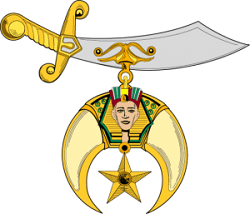
The Salutation
Dr. Fleming and his coworkers also formulated a salutation used today by Shriners—“Es Selamu Aleikum!”—which means, “Peace be with you!” In returning the salutation, the gracious wish is “Aleikum Es Selamu,” which means “With you be peace.”
The Fez
The red fez with a black tassel, the Shrine’s official headgear, has been handed down through the ages. It derives its name from the place where it was first manufactured — the holy city of Fez, Morocco.
Some historians claim it dates back to about A.D. 980, but the name of the fez, or tarboosh, does not appear in Arabic literature until around the 14th century. One of the earliest references to the headgear is in “Arabian Nights.”
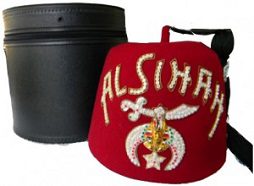
The First Meeting
On September 26, 1872, in the New York City Masonic Hall, the first Shrine Temple in the United States was organized. Brother McClenachan and Dr. Fleming had completed the ritual and proposed that the first Temple be named Mecca. The original 13 Masons of the Knickerbocker Cottage lunch group were named Charter Members of Mecca Temple (Mecca Shriners). Noble Florence read a letter outlining the “history” of the Order and giving advice on the conduct of meetings. The officers elected were Walter M. Fleming, Potentate; Charles T. McClenachan, Chief Rabban; John A. Moore, Assistant Rabban; Edward Eddy, High Priest and Prophet; George W. Millar, Oriental Guide; James S. Chappel, Treasurer; William S. Paterson, Recorder; and Oswald M. d’Aubigne, Captain of the Guard.
But the organization was not an instant success, even though a second Temple was chartered in Rochester in 1875. Four years after the Shrine’s beginnings, there were only 43 Shriners, all but six of whom were from New York.
The Imperial Council
At a meeting of Mecca Shriners on June 6, 1876, in the New York Masonic Temple, a new body was created to help spur the growth of the young fraternity. This governing body was called “The Imperial Grand Council of the Ancient Arabic Order of the Nobles of the Mystic Shrine for the United States of America.” Fleming became the first Imperial Grand Potentate, and the new body established rules for membership and the formation of new Temples. The initiation ritual was embellished, as was the mythology about the fraternity. An extensive publicity and recruiting campaign was initiated.
It worked. Just two years later, in 1878, there were 425 Shriners in 13 Temples. Five of these Temples were in New York, two were in Ohio and the others were in Vermont, Pennsylvania, Connecticut, Iowa, Michigan and Massachusetts.
The Shrine continued to grow during the 1880s. By the time of the 1888 Annual Session (convention) in Toronto, there were 7,210 members in 48 Temples located throughout the United States and one in Canada.
While the organization was still primarily social, instances of philanthropic work became more frequent. During an 1888 Yellow Fever epidemic in Jacksonville, Fla., members of the new Morocco Shriners and Masonic Knights Templar worked long hours to relieve the suffering populace. In 1889, Shriners came to the aid of the Johnstown Flood victims. In 1898, there were 50,000 Shriners, and 71 of the 79 Temples were engaged in some sort of philanthropic work.
By the turn of the century, the Shrine had come into its own. At its 1900 Imperial Session, representatives from 82 Temples marched in a Washington, D.C., parade reviewed by President William McKinley. Shrine membership was well over 55,000.
Evolution of The “World’s Greatest Philanthropy”
The Shrine was unstoppable in the early 1900s. Membership grew rapidly, and the geographical range of Temples widened. Between 1900 and 1918, eight new Temples were created in Canada, and one each in Honolulu, Mexico City and the Republic of Panama. The organization became, in fact, the Ancient Arabic Order of the Nobles of the Mystic Shrine for North America. New flourishes were added to a growing tradition of colorful pageantry. More Shrine bands were formed. The first Shrine circus is said to have opened in 1906 in Detroit.
During the same period, there was growing member support for establishing an official Shrine charity. Most Temples had individual philanthropies, and sometimes the Shrine as an organization gave aid. After the 1906 earthquake in San Francisco, the Shrine sent $25,000 to help the stricken city, and in 1915, the Shrine contributed $10,000 for the relief of European war victims. But neither the individual projects nor the special one-time contributions satisfied the membership, who wanted to do more.
In 1919, Freeland Kendrick (Lu Lu Shriners, Philadelphia) was the Imperial Potentate-elect for the 363,744 Shriners. He had long been searching for a cause for the thriving group to support. In a visit to the Scottish Rite Hospital for Crippled Children in Atlanta, he became aware of the overwhelming needs of crippled children in North America. At the June 1919 Imperial Session, Kendrick proposed establishing “The Mystic Shriners Peace Memorial for Friendless, Orphaned and Crippled Children.” His resolution never came to a vote. As Imperial Potentate in 1919 and 1920, he traveled more than 150,000 miles, visiting a majority of the 146 Temples and campaigning for an official Shrine philanthropy.
The climax came at the June 1920 Imperial Session in Portland, Oregon. Kendrick changed his resolution to one establishing the “Shriners Hospital for Crippled Children,” to be supported by a $2 yearly assessment from each Shriner (now $5 per year).
Conservative Shriners expressed doubts about the Shrine assuming this kind of responsibility. Prospects for approval were dimming when Noble Forrest Adair (Yaarab Shriners, Atlanta) rose to speak:
“I was lying in bed yesterday morning, about four o’clock . . . and some poor fellow who had strayed from the rest of the band . . . stood down there under the window for 25 minutes playing ‘I’m Forever Blowing Bubbles.’ ”
He said that when he awoke later, “I thought of the wandering minstrel, and I wondered if there were not a deep significance in the tune that he was playing for Shriners, ‘I’m Forever Blowing Bubbles.’ ”
He noted, “While we have spent money for songs and spent money for bands, it’s time for the Shrine to spend money for humanity.“
I want to see this thing started. Let’s get rid of all the technical objections. And if there is a Shriner in North America,” he continued, “who objects to having paid the two dollars after he has seen the first crippled child helped, I will give him a check back for it myself.”
When he was through, Noble Adair sat down to thunderous applause. The whole tone of the session had changed. There were other speakers, but the decision had already been reached. The resolution was passed unanimously.
A committee was chosen to determine the site and personnel for the Shriners Hospital. After months of work, research and debate, the committee concluded that there should be not just one hospital but a network of hospitals throughout North America. It was an idea that appealed to Shriners, who liked to do things in a big and colorful way. When the committee brought the proposal to the 1921 Imperial Session in Des Moines, Iowa, it too was passed.
First Hospital
Before the June 1922 Session, the cornerstone was in place for the first Shriners Hospital for Crippled Children in Shreveport, La. The rules for this hospital, and all the other Shriners Hospitals which would follow, were simple: To be admitted, a child must be from a family unable to pay for the orthopaedic treatment he would receive (this is no longer a requirement), be under 14 years of age (later increased to 18) and be, in the opinion of the chief of staff, someone whose condition could be helped.
The work of the great Shriners Hospitals network is supervised by the members of the Board of Trustees, who are elected at the annual meeting of the hospital corporation. Each hospital operates under the supervision of a local Board of Governors, a chief of staff and an administrator. Members of the boards are Shriners, who serve without pay.
The network of orthopaedic hospitals grew as follows: Shreveport, Sept. 16, 1922; Honolulu, Jan. 2, 1923; Twin Cities, March 12, 1923; San Francisco, June 16, 1923 (relocated to Sacramento in 1997); Portland, Jan. 15, 1924; St. Louis, April 8, 1924; Spokane, Nov. 15, 1924; Salt Lake City, Jan. 22, 1925; Montreal, Feb. 18, 1925; Springfield, Feb. 21, 1925; Chicago, March 20, 1926; Philadelphia, June 24, 1926; Lexington, Nov. 1, 1926; Greenville, Sept. 1, 1927; Mexico City, March 10, 1945; Houston, Feb. 1, 1952; Los Angeles, Feb. 25, 1952; Winnipeg, March 16, 1952 (closed Aug. 12, 1977); Erie, April 1, 1967; Tampa, Oct. 16, 1985, and Sacramento, Calif., April 14, 1997. This newest Shriners Hospital is the only one in the Shrine system that provides orthopaedic, burn and spinal cord injury care, and conducts research, all in a single facility.
The first patient to be admitted in 1922 was a little girl with a club foot from the red clay country south of Shreveport, La., who had learned to walk on the top of her foot rather than the sole. The first child to be admitted in Minneapolis was a Blackfoot Indian boy suffering from the deformities of polio. Since that time, more than 700,000 children have been treated at the 22 Shriners Hospitals. Surgical techniques developed in Shriners Hospitals have become standard in the orthopaedic world. Thousands of children have been fitted with arm and leg braces and artificial limbs, most of them made in special labs in the hospitals by expert technicians.
Orthopaedic Research
From 1950 to 1960, the Shrine’s funds for helping children increased rapidly. At the same time, the waiting lists of new patients for admission to Shriners Hospitals began to decline, due to the polio vaccine and new antibiotics. Thus, Shriners found themselves able to provide additional services, and Shrine leaders began to look for other ways they could help the children of North America.
One result was the collating of the medical records of patients of Shriners Hospitals. By placing the records of each patient and treatment on computer and microfilm, valuable information was made available to all Shriners surgeons and the medical world as a whole. This process, begun in 1959, also made it easier to initiate clinical research in Shriners orthopaedic hospitals.
Shriners Hospitals had always engaged in clinical research, and in the early ’60s, the Shrine aggressively entered the structured research field and began earmarking funds for research projects. By 1967, Shriners were spending $20,000 on orthopaedic research. Today, the annual research budget totals approximately $25 million. Shrine researchers are working on a wide variety of projects, including studies of bone and joint diseases, such as juvenile rheumatoid arthritis; increasing basic knowledge of the structure and function of connective tissue; and refining functional electrical stimulation, which is enabling children with spinal cord injuries to have limited use of their arms and legs.
Entering the Burn Care Field
This expansion of orthopaedic work was not enough for the Shriners. They had enough funds to further expand their philanthropy. The only question was: What unmet need could they fill?
A special committee was established to explore areas of need and found that burn treatment was a field of service that was being bypassed. In the early ’60s, the only burn treatment center in the United States was part of a military complex. The committee was ready with a resolution for the 1962 Imperial Session in Toronto. The resolution, dated July 4, 1962, was adopted by unanimous vote.
On November 1, 1963, the Shrine opened a seven-bed wing in the John Sealy Hospital on the University of Texas Medical Branch in Galveston as an interim center for the care of severely burned children. On February 1, 1964, the Shrine opened a seven-bed ward in the Cincinnati General Hospital on the campus of the University of Cincinnati. A third interim operation, a five-bed ward, was opened March 13, 1964, in the Massachusetts General Hospital (Boston) under the direction of Harvard Medical School.
While children were being treated in these wards, separate buildings were constructed near each interim location. These buildings, three 30-bed pediatric burn hospitals, were designed to meet the special needs of burned children. At each, the staffs remain affiliated with their neighboring universities so that they may better carry out their three-fold program of treatment, research and teaching.
The hospital in Galveston opened March 20, 1966; the hospital in Cincinnati opened February 19, 1968; and the Boston hospital opened November 2, 1968. New facilities would be constructed for all three burn hospitals in the 1990s. The new Cincinnati and Galveston hospitals were completed in 1992, and the new Boston hospital was completed in 1999.
A new burn treatment center opened in 1997, in the new Shriners Hospital in Sacramento, Calif. This newest Shriners Hospital provides orthopaedic, burn and spinal cord injury care, and serves as the Shrine’s primary burn treatment center in the western United States. The Sacramento Hospital also conducts research into all three disciplines.
Since the Shriners opened their burn hospitals in the 1960s, a burned child’s chance of survival has more than doubled. They have saved children burned over 90 percent of their bodies. The techniques they have pioneered to prevent the crippling effects of severe burns have made a normal life possible for thousands of burn victims.
Most importantly, perhaps, the establishment of the burn Shriners Hospitals has alerted the medical world to this special need, which has, in turn, led to the establishment of non-Shrine burn centers throughout North America.
At Shriners Hospitals the work goes on, continually searching for new ways to heal severe burns and reduce or, as much as possible, eliminate the crippling and scarring effects of those burns. Because of the special nature of the burn hospitals, they will surely always be on the frontier of burn care.
Continuing the Commitment
During the 1980s, Shriners Hospitals initiated a number of new programs in their efforts to continue providing high-quality pediatric orthopaedic and burn care. One of the most significant was the 1980 opening of the spinal cord injury (SCI) rehabilitation unit at the Shriners Hospital in Philadelphia — the first spinal cord injury unit in the United States designed specifically for children and teenagers who suffer from these injuries. By 1984, two additional spinal cord injury units were operating in the Shriners Hospitals in Chicago and San Francisco. In 1997, the San Francisco Hospital, including the SCI unit, was relocated to the newest Shriners Hospitals in Sacramento, Calif.
At the Shrine’s SCI units, children receive long-term rehabilitative care and physical and occupational therapy to help them relearn the basic skills of everyday life. Counseling sessions help patients learn to cope with the emotional aspects of their injury and help them lead fulfilling lives by emphasizing the abilities they still have. Patients may enter an SCI unit apprehensive about the future, but after months of encouragement and support, they often leave with a sense of hope and optimism.
An ongoing study at the Philadelphia Hospital is giving children with cerebral palsy and spinal cord injuries a sense of hope as well. Researchers have found that when using functional electrical stimulation (FES), the posture of a child’s foot and ankle is improved. In turn, it has a positive effect on their gait, making walking an achievable goal.
Another important undertaking that was begun during the 1980s was an aggressive rebuilding and renovation program, involving the construction of new facilities and extensive renovations throughout the Shriners Hospital system. In 1981, the Representatives at the 107th Imperial Council Session approved a major expansion and reconstruction program, which included the construction of a new orthopaedic hospital in Tampa, Fla. The opening of the Tampa Hospital in 1985 — the first new hospital added to the Shrine system since the 1960s — brought the Shriners Hospital system back to 22 hospitals. Since 1981, 21 Shriners Hospitals have either been rebuilt or totally renovated. In 1998, the Joint Boards decided to build a new facility for the Mexico City Hospital, which underwent extensive renovations in 1989.
In 1989, another significant decision was made when the Shriners voted to construct a new hospital in the Northern California region, to replace the existing San Francisco Hospital. In 1990, Sacramento was chosen as the site for the new hospital. Construction began in 1993, and in 1997, the new Northern California Hospital in Sacramento opened its doors.
Also during the 1980s, because of the high number of patients with myelodysplasia (spina bifida), many of the Shriners Hospitals developed special programs to provide comprehensive, multidisciplinary care to these patients.
Previously, Shriners Hospitals had provided the orthopaedic care these children needed, but in 1986, the Joint Boards of Directors and Trustees approved a policy permitting the hospitals to address the multiple needs of these children by providing their medical, neurosurgical and urological requirements, as well as their psychosocial, nutritional and recreational needs.
During the 1980s, the Los Angeles and Springfield Shriners Hospitals expanded their prosthetic services with regional prosthetic research programs. Both programs conduct research into ways to improve or create new prosthetics and help rehabilitate limb-deficient children. These two programs, in addition to various other research programs throughout the 22 hospital system, join the prosthetic and orthotic labs throughout the Shriners Hospital system in ensuring that Shriners Hospitals remain leaders in the field of children’s orthotics and prosthetics.
The burn hospitals also took steps to ensure that burn patients continue to receive the most advanced burn treatment available. The Shriners Hospital in Cincinnati initiated a burns air ambulance, the first air ambulance in the country devoted exclusively to transporting burn victims. The burn hospitals also developed a re-entry program, to assist burn patients in their return home after being discharged from the hospital. During 1992, new replacement facilities for the Cincinnati and Galveston burn hospitals were dedicated, and groundbreaking ceremonies were held for a new facility for the Boston Hospital. All the burn hospitals are continuing to conduct research in their ongoing efforts to improve care for burned patients.
In 1996, Shrine Representatives took another significant step when they voted to officially change the name of their philanthropy to “Shriners Hospitals for Children.” In a move that permanently eliminated the word “crippled” from the organization’s corporate name, the Representatives made the change in an effort to have the name better reflect the mission of Shriners Hospitals and the expansions of services that have been added over the years, including the opening of the burn hospitals and the addition of programs of comprehensive care for children with myelodysplasia. The new name is intended to reflect the philosophy of Shriners Hospitals, which provide medical care for children totally free of charge, based only on what’s best for the child. The new name, likewise, does not label children in any way, but simply recognizes them for what they are: children. Though they have a new name, Shriners Hospitals continue to focus on their mission of helping children lead better lives.
One way Shriners Hospitals is helping to improve lives is with the help of Outcomes research. This type of research looks for opportunities to improve Shriners Hospital practices, both clinical and operational, to help bring better care and quality of life to patients. The Outcomes studies utilize more than one Shriners Hospital, and the projects, studies and performance improvement initiatives directly impact changes in operations and patient care practices at all 22 Shriners Hospitals.
To ensure Shriners Hospitals is constantly on the cutting edge of research, Shriners enlists the help of advisory boards, which are made up of eminent surgeons, clinicians and scientists who review grants and offer expertise on project funding. The Medical Advisory Board, Research Advisory Board and Clinical Outcomes Studies Advisory Board also provide review, guidance and subjective assessment to many areas of Shriners Hospitals.
As they look to the future, the Joint Boards are committed to maintaining Shriners Hospitals for Children as leaders in children’s pediatric orthopaedic and burn care.
The Fraternity Flourishes
As the hospital network grew, the fraternity continued in its grand tradition. In 1923, there was a Shriner in the White House, and Noble/President William G. Harding reviewed the Shriners parade at the 1923 Imperial Session in Washington, D.C.
The East/West Shrine Game
The East/West Shrine College All-Star Football Game was established in 1925, in San Francisco with the motto “Strong Legs Run So Weak Legs May Walk.” Throughout its history, this traditional post-season game has raised millions of dollars for Shriners Hospitals and helped millions of people become more familiar with the story of Shriners Hospitals. In this, as in other Shrine football games, the young players visit patients at, so the players themselves know the real purpose of the game.
The Peace Memorial
In 1930, the Imperial Session was to be held in Toronto. For his Session, Imperial Potentate Leo V. Youngworth wanted something special. With the appropriate approval, the leader of 600,000 Shriners commissioned a peace monument to be built in Toronto. It was to face south, commemorating 150 years of friendship between the United States and Canada.
The Peace Memorial was relocated and rededicated during the 1962 Imperial Session, and it stands today outside the National Exposition grounds in Toronto. When the Shriners returned to Toronto in 1989, for the 115th Imperial Council Session, the memorial was again rededicated, representing a renewed commitment to the Shrine’s international brotherhood and fraternalism. The plaque reads: “Erected and dedicated to the cause of universal peace by the Ancient Arabic Order of the Nobles of the Mystic Shrine for North America June 12, 1930.”
The 1930 Session was the Shrine’s own antidote to the pervasive gloom of the Great Depression. But it was only temporary. Not even Shriners could escape the Depression. For the first time in its history, the Shrine began to lose members — the Nobles just could not pay their dues.
The struggle to keep the hospitals and the fraternity going during these years was enormous. It was necessary to dip into the Endowment Fund capital to cover operating costs of the hospitals. To ensure the financial distinction between the hospitals and the fraternity, a corporation for each was established in 1937.
The Shrine and its hospitals somehow survived the Depression. In the 1940s, like the rest of North America, the Shrine adjusted to wartime existence. Imperial Sessions were limited to business and were attended only by official Temple Representatives. Shrine parade units stayed home and marched in local patriotic parades. During the four years of war, more than $1 billion was invested by and through the Shrine in government war bonds. The hospital corporation also invested all of its available funds in government securities. After World War II, the economy improved, and men found renewed interest in fraternalism. By 1942, membership was once more increasing.
Shriners International Headquarters
Until 1928, the Shrine’s national offices were in Richmond, Va. With the growth of the fraternity, there were increasing pressures to locate Shrine headquarters in some city that would be more convenient to all Temples. Thus, in 1958, the building at 323 North Michigan Avenue, Chicago, was purchased. At a special Session held April 10th, 1978, in Tampa, Fla., representatives voted to relocate Shrine Headquarters to 2900 Rocky Point Drive, Tampa. The Tampa headquarters houses the administrative personnel for both the Iowa (fraternal) and Colorado (Shriners Hospitals) corporations, fraternal and hospital records, the attorneys who monitor the many estates involved in Shriners Hospitals for Children, and the various other departments that support the day-to-day operations of the Shrine fraternity and Shriners Hospitals for Children.
An expansion project was begun in 1987 to meet the ever-increasing needs of the Shrine and Shriners Hospitals. A third wing, or pod, was added to the rear of the existing building, and the board room and executive offices for the fraternity and hospital system were relocated to the new area, allowing several departments to expand their offices in the original sections. The new, enlarged board room provides space for meetings of the Joint Boards and their committees, and for conferences.
In 1993, the Commemorative Plaza was built, with its larger than life-size statue of a Shriner carrying a child. The statue represents what has become known as the “Editorial Without Words,” probably one of the best-recognized symbols of Shriners Hospitals for Children.
The polished marble plaza features a semi-circular wall engraved with the names of every Imperial Potentate (Chief Executive Officer) of the Shrine and his year served. In addition, below the statue is a cylindrical base engraved with the names of the 22 Shriners Hospitals and surrounded by a fountain. Around the fountain are large inlaid marble squares bearing the engraved names of each of the Shrines 191 Temples, each Temple’s city and state, year of incorporation and the Shrine insignia (the scimitar). To the rear of the Commemorative Plaza and in front of the headquarters building are four flag poles topped with flags of the United States, Canada, Mexico and Panama, representing the countries with Shrine membership.
In early 1999, a major construction and renovation effort was begun that would add 35,000 square feet to the existing facility, bringing the total office area to about 120,000 square feet. This effort was initiated to accommodate the healthcare initiatives and trends taking place in the industry in the late 1990s. The exterior work came to an end in December 2001, with the installation of a three-dimensional 11-by-9-foot Shrine scimitar on the front of the building. The new windows on the building have a bluish- green tint, giving the building a different appearance than the gold tinted windows, which served as a landmark to identify the headquarters for two decades. On Feb. 24, 2002, the newly renovated Shriners International Headquarters was rededicated.
The Shrine of North America — How The Organization Works
Shrine Temples are located throughout the United States, Canada, Mexico and the Republic of Panama, with Shrine Clubs around the world. There is, therefore, a special Shrine Pledge of Allegiance: “I pledge allegiance to my flag, and to the country for which it stands, one nation under God, indivisible, with liberty and justice for all.” Wherever Shriners gather, the national flags of the United States, Canada, Mexico and the Republic of Panama are flown.
Today, there are nearly 500,000 Shriners who belong to 191 Shrine Temples, or chapters, from Al Aska Shriners in Anchorage, Alaska, to Abou Saad Shriners in Panama, and from Aloha Shriners in Honolulu to Philae Shriners in Halifax, Nova Scotia. Temple memberships range from approximately 11,000 (Murat Shriners in Indianapolis) to about 420 (Media Shriners in Watertown, NY).
The Temples, their Units and affiliated Shrine Clubs embody the true spirit of fraternalism, and wherever a Shriner goes, he can be certain there are Nobles who will extend their hand in greeting and call him “Brother.”
To better understand how all this works, an observer can start at a local Temple. All Temples are run by an elected Divan (officers), headed by the Potentate and the Chief Rabban. A Recorder, or record keeper/administrator, usually maintains an office at the Temple. One member is elected or appointed to the “lowest rung” each January and under traditional practice moves up one “rung” each year. Thus, by the time he becomes Potentate of his Temple, a Shriner usually has at least four years of experience in Temple leadership.
Stated meetings of the Temple membership as a whole must be held at least four times a year. In addition, each Temple holds one or more ceremonials every year for the induction of new members. There are also many Temple, Unit, and Shrine Club social events each year.
Units are smaller groups within a Temple which are organized for a specific purpose. Many of these are the uniformed Units so familiar to parade watchers: Oriental Bands, Shrine Bands, Horse and Motor Patrols, Highlander Units, Clowns, Drum Corps, Chanters, and Legions of Honor. Other Temple Units can include hospital hosts or guides, and transportation Units which work closely with their local Shriners Hospital — either with the children at the hospital or in transporting patients to and from the hospital.
Each Temple has a clearly defined territory from which it can obtain new members. Since these jurisdictions are often quite large, smaller geographical units may be organized for fellowship purposes. These are the Shrine Clubs, under the control of their mother Temple.
In addition, any number of Temples may form a Shrine Association for social conventions, if the Imperial Council issues an appropriate charter. There are currently 20 Regional Associations and 19 Shrine Unit Associations.
The 191 Shrine Temples are governed by the Imperial Council, which is composed of Representatives. The Representatives of the Imperial Council include all past and present Imperial Officers, Emeritus Representatives (who have served 15 years or more), and Representatives elected from each Temple. A Temple may have two Representatives if its membership exceeds 300, three if more than 600, and four if more than 1,000. These Representatives meet once a year — usually in July at the Imperial Council Session — to make policy decisions and legislation regarding both the fraternity and the hospitals. With nearly 900 Representatives, the Imperial Council constitutes one of the largest legislative bodies in the world. The Representatives also elect the Imperial Officers. The President of the Colorado Corporation and members of the Board of Trustees for Shriners Hospitals for Children are elected by the members of the Colorado Corporation.
The Imperial Divan, the Shrine’s international governing body, consists of 13 officers plus an Imperial Chaplain. The Imperial Treasurer and the Imperial Recorder may be elected for several consecutive years; they are the only officers receiving any type of compensation. As with Temple Divans, an officer (with the exception of Treasurer and Recorder) is elected to the bottom of the Divan and, barring unforeseen circumstances, moves up one position each year. These officers, elected from among the Representatives, are usually past Temple Potentates. The Divan plus the immediate Past Imperial Potentate constitute the Board of Directors of the fraternal corporation and they, with the Chairman of the Board of Trustees, constitute the Board of Directors of the hospital corporation.
The chief executive officer for the Shrine of North America is the Imperial Potentate, who is elected for one year. He visits many of the Shrine Temples and hospitals and generally supervises both fraternal and hospital policy.
To help him with these tasks, the Imperial Potentate appoints committees to implement the various Shrine programs. One of the most important of these committees is the Endowments, Wills and Gifts Committee, which coordinates and supervises contributions and bequests given to Shriners Hospitals for Children.
The day-to-day operations — keeping the records and accounts of the fraternity and hospitals, supervising the estates left to Shriners Hospitals and producing printed materials for the entire Shrine organization — are carried out at International Headquarters in Tampa. These offices are supervised by an executive vice president of the Imperial Council, an executive vice president of Shriners Hospitals, and a legal department, which is under the supervision of a managing attorney.
However, complex the Shrine may seem, its essence is the fraternal fellowship for which it was originally founded. It has been said that there are no strangers in Shrinedom. This is evident in the great times and laughter wherever Shriners get together, whether in a local Shrine Club meeting, a Temple ceremonial, a Shrine Association gathering or an Imperial Session. All Shriners share not just a Masonic background but a zest for living.
Though this quality remains consistent — from the original 13 members to the hundreds of thousands of Shriners today — the Shrine has adapted to many changes. Many more Temple and convention activities include the families of Shriners. Today, many Shriners are deeply involved in Shriners Hospital work in addition to their fraternal activities.
Most Shrine Temples sponsor fund-raising events to provide funds for Shriners Hospitals. In one calendar year there can be nearly 500 of these events, which range from the East/West Shrine Game and other football games to horse shows, hospital paper sales, and miscellaneous sports and social events.
During the 1980s, Shriners Hospitals experienced the greatest expansion in their history, with major building programs, increasing numbers of patients receiving care, and expansion of services. As the new millennium approaches, all 22 Shriners Hospitals are maintaining their position at the forefront of specialized pediatric orthopaedic and burn care. The Joint Boards plan to continue updating their facilities, expanding their research programs and increasing their ability to meet the needs of thousands of children in need of expert orthopaedic and burn care. In this way, Shriners Hospitals will continue to meet a special need for children.
Thus, whatever changes occur within the fraternal organization or within the Shriners Hospital system, the Shrine of North America will remain the “World’s Greatest Fraternity,” operating and maintaining the “World’s Greatest Philanthropy.”
Es Selamu Aleikum.
Courtesy: George Washington Masonic Memorial

